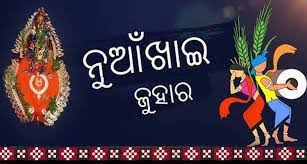The harvest festival of Nuakhai takes place the day after Ganesh Chaturthi. All of Odisha celebrates Nuakhai, but Sambalpur, Balangir, Jharsuguda, Sonepur, Boudh, Bargarh, Sundargarh, Kalahandi, and Nuapada refer to it as the festival of Western Odisha.
This ancient celebration honours farmers’ toil and is held in the hope that it will bring them prosperity. The nine sets of rites that make up the preparation—Beheren, Lagana Dekha, Daka Haka, Sapha Sutura, Kina Bika, Nua Dhana Khuja, Bali Pakka, Prasad, and Juhar Bhet—begin 15 days ahead.
In the verandah and on the mud walls, rangolis are created. Drawing this white Rangoli required the use of fingertips dipped in rice water. People dress in brand-new gowns for this event. The family patriarch presents the fresh rice to the household god. The new rice is given to the other family members after giving thanks to Mother Earth for supplying them with food for their maintenance. The family’s junior members all bow to their elders after this. Then comes the Nuakhai Juhar, which is the welcome of friends, family, and well-wishers. They return home to celebrate this event, no matter where they may be staying. This is one holiday where they congregate and share a meal.
There are created sweet foods such as Arisa, Kakra, Manda, Khatta, Ghanta Tarkari Chakuli, Mug-bara, and Kheeri. Additionally, non-vegetarian food is prepared, particularly mutton curry.
Popular folk dance genres including Dalkhai, Rasarkeli, Maelajada, Bajnia, and Chutkuchuta are performed to the rhythms of the melodic Sambalpuri songs and traditional musical instruments like the Dhol, Taasaa, and Nisan.
Additionally, a number of organisations hold Nuakhai Bhetghat in the evening, where folk music and dances are performed to showcase the regional customs and culture.



